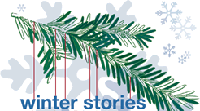 White snow, bright snow! As the winter season settles in, winter stories offer readers opportunities for icy and playful antics or staying warm inside and reading a good book. The International Reading Association's Children’s Literature and Reading Special Interest Group offers winter reading in this week’s column. With a mixture of fiction and nonfiction, educators will find some good reading for those indoor recesses or a table full of beautiful books for browsing. Also, ReadWriteThink offers a sleighful of great teaching ideas with snowy, wintery themes.
White snow, bright snow! As the winter season settles in, winter stories offer readers opportunities for icy and playful antics or staying warm inside and reading a good book. The International Reading Association's Children’s Literature and Reading Special Interest Group offers winter reading in this week’s column. With a mixture of fiction and nonfiction, educators will find some good reading for those indoor recesses or a table full of beautiful books for browsing. Also, ReadWriteThink offers a sleighful of great teaching ideas with snowy, wintery themes.
K-3
Bruchac, James and Joseph. (2012). Rabbit’s snow dance; a traditional Iroquois story. Illustrated by Jeff Newman. New York: Dial Books for Young Readers.
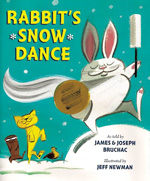 Father and son storytelling team borrow from an old Iroquois tale to present the story of Rabbit and how he lost his tale. It begins in the summer when impatient long-tailed rabbit would like to be munching the luscious leaves at the top of the trees, knowing his snowshoe-like feet would let him do this easily if only the ground were covered with snow. He decides to use his drum and chant the snow song to bring the snow even though it is a hot summer day. The other forest animals are not a bit happy with this decision, but rabbit doesn’t care. He begins his dance with drum in hand and chants and chants, “Azikanapo!” (p.4) After a long time chanting the snow beings to fall and fall and fall. The ground is covered, short trees are covered, and his animal friends are covered, all but the tallest trees are covered. Exhausted from all this chanting, Rabbit takes a nap in the tallest tree. Now that the chanting has stopped and the bright sun is still shining on this summer day, the snow melts rapidly. When rabbit wakes up, he falls out of the tree and bits of his long tail are snagged on branches all the way down to the ground. When he lands at the bottom, he only has his small cottontail left. Read more about this book at the American Indians in Children’s Literature blog, or use some of the author’s videos about animals and storytelling at his website.
Father and son storytelling team borrow from an old Iroquois tale to present the story of Rabbit and how he lost his tale. It begins in the summer when impatient long-tailed rabbit would like to be munching the luscious leaves at the top of the trees, knowing his snowshoe-like feet would let him do this easily if only the ground were covered with snow. He decides to use his drum and chant the snow song to bring the snow even though it is a hot summer day. The other forest animals are not a bit happy with this decision, but rabbit doesn’t care. He begins his dance with drum in hand and chants and chants, “Azikanapo!” (p.4) After a long time chanting the snow beings to fall and fall and fall. The ground is covered, short trees are covered, and his animal friends are covered, all but the tallest trees are covered. Exhausted from all this chanting, Rabbit takes a nap in the tallest tree. Now that the chanting has stopped and the bright sun is still shining on this summer day, the snow melts rapidly. When rabbit wakes up, he falls out of the tree and bits of his long tail are snagged on branches all the way down to the ground. When he lands at the bottom, he only has his small cottontail left. Read more about this book at the American Indians in Children’s Literature blog, or use some of the author’s videos about animals and storytelling at his website.
- Karen Hildebrand, Ohio Library and Reading Consultant
Calder, C.J. (2013). Snow Truck. Illus. by Ronnie Rooney. Mankato, MN:Stone Arch Books/Capstone Press.
 This board book is a perfect introduction to snow and colors for those really early readers. As blue truck starts slipping and sliding down a mountain path a bright red cardinal is watching it happen. When blue truck calls for help, snowplow red truck is there for the rescue. Along comes green truck with his plow and they pile a load of sand to create a barrier for blue truck. “Ka-thunk!” (unp.) He bumps into the pile and lands safely. Working together to solve a problem is the overall theme and young readers will enjoy following the red bird on each page of the story.
This board book is a perfect introduction to snow and colors for those really early readers. As blue truck starts slipping and sliding down a mountain path a bright red cardinal is watching it happen. When blue truck calls for help, snowplow red truck is there for the rescue. Along comes green truck with his plow and they pile a load of sand to create a barrier for blue truck. “Ka-thunk!” (unp.) He bumps into the pile and lands safely. Working together to solve a problem is the overall theme and young readers will enjoy following the red bird on each page of the story.
- Karen Hildebrand, Ohio Library and Reading Consultant
DeGezelle, Terri. (2013). Exploring winter. Mankato, MN: Capstone Press.
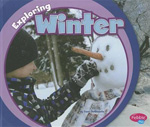 Intended for primary grades and our earliest readers, this book takes a look at winter through facts about the science of winter. Text on one side, a photograph on the other, information about winter includes facts about cold, changing seasons and the planets, amount of daylight, freezing water, plants and animals in winter, and differences in hemispheres. A glossary and short bibliography are included at the end with internet sources including projects, games and more at the publisher website.
Intended for primary grades and our earliest readers, this book takes a look at winter through facts about the science of winter. Text on one side, a photograph on the other, information about winter includes facts about cold, changing seasons and the planets, amount of daylight, freezing water, plants and animals in winter, and differences in hemispheres. A glossary and short bibliography are included at the end with internet sources including projects, games and more at the publisher website.
- Karen Hildebrand, Ohio Library and Reading Consultant
deMarin, Layne. (2013). Too much snow! Mankato, MN: Capstone Press.
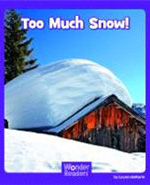 From the series Wonder Readers this little volume offers large primary text for early independent readers about snow. A short paragraph with one to three sentences per page that includes a color photograph on each page helps extend the text. Chapters of two to four pages include topics of snowflakes, blizzards, storm stories, weather warnings and a glossary. Additional activities can be found in “Now Try This!” (p. 19) with internet sites included. Further activities can be found at the publisher's website.
From the series Wonder Readers this little volume offers large primary text for early independent readers about snow. A short paragraph with one to three sentences per page that includes a color photograph on each page helps extend the text. Chapters of two to four pages include topics of snowflakes, blizzards, storm stories, weather warnings and a glossary. Additional activities can be found in “Now Try This!” (p. 19) with internet sites included. Further activities can be found at the publisher's website.
- Karen Hildebrand, Ohio Library and Reading Consultant
Edison, Erin. (2013). Snow. Mankato, MN: Capstone Press.
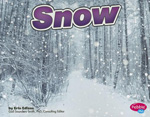 This introduction to snow could be very useful for teachers to read aloud. It is big enough to share with a class and the photographs are full page so that students can easily see them. Factual information about snow is written in primary enlarged text with contents including: what is snow? Types of snow; snow dangers; glossary. Additional resources and further activities are also included at the end of the book. The photography is the outstanding feature of this book, particularly the close-ups of snowflakes.
This introduction to snow could be very useful for teachers to read aloud. It is big enough to share with a class and the photographs are full page so that students can easily see them. Factual information about snow is written in primary enlarged text with contents including: what is snow? Types of snow; snow dangers; glossary. Additional resources and further activities are also included at the end of the book. The photography is the outstanding feature of this book, particularly the close-ups of snowflakes.
- Karen Hildebrand, Ohio Library and Reading Consultant
Ghigna, Charles. (2012). I see winter. Illus. by Ag Jatkowska. Mankato, MN: Capstone Press.
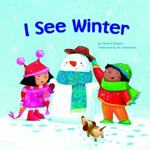 Beginning with beautiful endpapers of snowflakes in shades of blues and purples, this simple rhymed text by author/poet Charles Ghigna, known as Father Goose, presents an idyllic picture of winter. “I see snowflakes passing by/ I see gray geese in the sky/I see shadows on the hill/ I see frost upon the sill.” (pages 1-4) As the short verse continues, the story ends with the Christmas season, hot chocolate and presents. From the cover to the pictures inside, the multicultural illustrations make this a good choice for all young audiences. Visit the author’s website for poetry writing ideas and watch the video to learn how he earned the moniker, Father Goose.
Beginning with beautiful endpapers of snowflakes in shades of blues and purples, this simple rhymed text by author/poet Charles Ghigna, known as Father Goose, presents an idyllic picture of winter. “I see snowflakes passing by/ I see gray geese in the sky/I see shadows on the hill/ I see frost upon the sill.” (pages 1-4) As the short verse continues, the story ends with the Christmas season, hot chocolate and presents. From the cover to the pictures inside, the multicultural illustrations make this a good choice for all young audiences. Visit the author’s website for poetry writing ideas and watch the video to learn how he earned the moniker, Father Goose.
- Karen Hildebrand, Ohio Library and Reading Consultant
Special note to get ready for Groundhog Day with nonfiction:
Gillenwater, Chadwick. (2013). Groundhogs. Mankato, MN: Capstone Press.
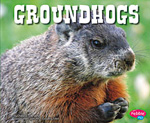 The outstanding close-up photography makes this primary book about groundhogs a stand out. Written with young readers in mind, basic information about groundhogs is included. Also known as woodchucks, facts about groundhogs abound detailing their claws and teeth and how they dig to create their underground burrows that sometimes reach 45 feet long. Small maps appear as inserts in the opening pages to give readers a visual as to where these critters live within the North American continent. Photographs of the newborn pups are especially interesting for children.
The outstanding close-up photography makes this primary book about groundhogs a stand out. Written with young readers in mind, basic information about groundhogs is included. Also known as woodchucks, facts about groundhogs abound detailing their claws and teeth and how they dig to create their underground burrows that sometimes reach 45 feet long. Small maps appear as inserts in the opening pages to give readers a visual as to where these critters live within the North American continent. Photographs of the newborn pups are especially interesting for children.
- Karen Hildebrand, Ohio Library and Reading Consultant
Hest, Amy. (2012). Charley’s first night. Illus. by Helen Oxenbury. Candlewick Press.
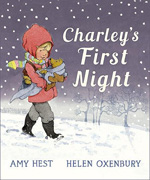 Young Henry Korn has found a puppy in the snow and just knows that it is the right thing to do to take him home. He brings his own blue baby blanket and carries the sweet little puppy home. When his parents see the puppy and agree that Henry can keep him, they set up a few ground rules. Henry has to be the one to feed the new addition as well as walk him everyday. Henry gladly accepts this responsibility and begins to take the newly named Charley around the house to introduce his new home. That evening, when Henry prepares a bed for Charley in the kitchen complete with warm blanket and a clock to click for comfort, Henry goes to bed. That is, he is in bed until he hears Charley crying. Henry lovingly goes back to his new friend and walks him around the house a bit and puts him back in bed. When the crying starts anew, Henry shows Charley his bedroom, which is exactly where Henry’s mother finds them cuddled together the next morning. Oxenbury’s soft pastels are the perfect complement to Hest’s gentle story about a new puppy. This warm and gentle story will make every reader want a puppy.
Young Henry Korn has found a puppy in the snow and just knows that it is the right thing to do to take him home. He brings his own blue baby blanket and carries the sweet little puppy home. When his parents see the puppy and agree that Henry can keep him, they set up a few ground rules. Henry has to be the one to feed the new addition as well as walk him everyday. Henry gladly accepts this responsibility and begins to take the newly named Charley around the house to introduce his new home. That evening, when Henry prepares a bed for Charley in the kitchen complete with warm blanket and a clock to click for comfort, Henry goes to bed. That is, he is in bed until he hears Charley crying. Henry lovingly goes back to his new friend and walks him around the house a bit and puts him back in bed. When the crying starts anew, Henry shows Charley his bedroom, which is exactly where Henry’s mother finds them cuddled together the next morning. Oxenbury’s soft pastels are the perfect complement to Hest’s gentle story about a new puppy. This warm and gentle story will make every reader want a puppy.
- Karen Hildebrand, Ohio Library and Reading Consultant
Hest, Amy. (2012). The reader. Illus. by Lauren Castillo. Las Vegas: Amazon Publishing.
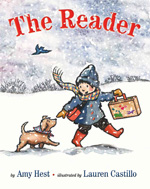 Accompanied by his faithful dog, a boy carrying a brown suitcase ventures outside into cold weather. Wearing a knitted hat, a scarf, a coat, and boots, he’s certainly ready for wintery temperatures. Together, the boy and dog head uphill where they frolic, enjoy a snack, and then best of all, share a read aloud about friendship. Early readers will enjoy trying to guess the contents of the suitcase and relish this unnamed reader’s delight in reading to his furry friend. Some of the vocabulary words are challenging, painting vivid word pictures that are mirrored in the snow-filled ink-and-watercolor illustrations. One of the most delightful illustrations shows circles of paw prints that surround the boy’s own sled tracks, testimony to the dog’s patience and the boy’s persistence in tugging that sled up the hill.
Accompanied by his faithful dog, a boy carrying a brown suitcase ventures outside into cold weather. Wearing a knitted hat, a scarf, a coat, and boots, he’s certainly ready for wintery temperatures. Together, the boy and dog head uphill where they frolic, enjoy a snack, and then best of all, share a read aloud about friendship. Early readers will enjoy trying to guess the contents of the suitcase and relish this unnamed reader’s delight in reading to his furry friend. Some of the vocabulary words are challenging, painting vivid word pictures that are mirrored in the snow-filled ink-and-watercolor illustrations. One of the most delightful illustrations shows circles of paw prints that surround the boy’s own sled tracks, testimony to the dog’s patience and the boy’s persistence in tugging that sled up the hill.
- Barbara A. Ward, Washington State University Pullman
Hutmacher, Kimberly M. (2013). Sled dogs. Mankato, MN: Capstone Press.
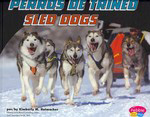 The beautiful dogs of the North are featured in this book; the Alaskan huskies, the Siberian huskies, and the Alaskan malamutes. Describing how these dogs work together as a team to pull the sleds and loads their drivers ask of them is the major content. The famous Iditarod race is featured early on in the book with photographs. The author goes on to give a few facts about how the dogs’ feet are protected with their footpads and how to train young puppies into becoming successful sled dogs. Additional information is included at the end of the book including a glossary. Students might be interested in viewing this video from DragonFly TV about kids and sled dogs.
The beautiful dogs of the North are featured in this book; the Alaskan huskies, the Siberian huskies, and the Alaskan malamutes. Describing how these dogs work together as a team to pull the sleds and loads their drivers ask of them is the major content. The famous Iditarod race is featured early on in the book with photographs. The author goes on to give a few facts about how the dogs’ feet are protected with their footpads and how to train young puppies into becoming successful sled dogs. Additional information is included at the end of the book including a glossary. Students might be interested in viewing this video from DragonFly TV about kids and sled dogs.
- Karen Hildebrand, Ohio Library and Reading Consultant
Meister, Cari. (2013). Winter is wonderful. Illus. by Jim Lingenfelter. Mankato, MN: Capstone Press.
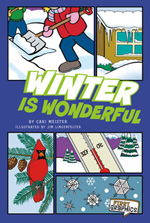 From the First Graphics series about graphic novels for early readers, author Cari Meister has created a science book about winter in the graphic/comic format. Using factual information about winter, animals in winter, plants and trees and even winter fun readers will learn about freezing temperature, snowflakes, the seasons in relation to the hemisphere, hibernation and migration, and fun sports and activities to do in cold and snowy weather. A glossary and further resource information are included at the end of the book.
From the First Graphics series about graphic novels for early readers, author Cari Meister has created a science book about winter in the graphic/comic format. Using factual information about winter, animals in winter, plants and trees and even winter fun readers will learn about freezing temperature, snowflakes, the seasons in relation to the hemisphere, hibernation and migration, and fun sports and activities to do in cold and snowy weather. A glossary and further resource information are included at the end of the book.
- Karen Hildebrand, Ohio Library and Reading Consultant
Pearson, Carrie A. (2012). A warm winter tail. Illus. by Christina Wald. Mount Pleasant, SC: Sylvan Dell.
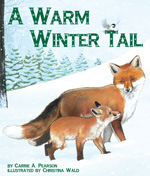 Turning the tables on humans and their curiosity about them, baby animals such as red foxes, box turtles, honeybees, and Monarch butterflies ask their mothers how humans cope during winter’s freezing months. All of the babies are sure that humans must have some way to adapt to the cold that is similar to their own adaptations, a conceit that turns out to be somewhat true as illustrated in the sketches of human clothing and shelter. Intriguingly, the illustrator has created sketches of human behavior in a black and white palette and the illustrations of the animals in larger, color illustrations, supporting the animals’ worldview. Back matter includes a matching activity and additional information on animal adaptation. Young readers will enjoy reading this title and finding even more activities on the publisher’s website.
Turning the tables on humans and their curiosity about them, baby animals such as red foxes, box turtles, honeybees, and Monarch butterflies ask their mothers how humans cope during winter’s freezing months. All of the babies are sure that humans must have some way to adapt to the cold that is similar to their own adaptations, a conceit that turns out to be somewhat true as illustrated in the sketches of human clothing and shelter. Intriguingly, the illustrator has created sketches of human behavior in a black and white palette and the illustrations of the animals in larger, color illustrations, supporting the animals’ worldview. Back matter includes a matching activity and additional information on animal adaptation. Young readers will enjoy reading this title and finding even more activities on the publisher’s website.
- Barbara A. Ward, Washington State University Pullman
Rule, Rebecca. (2012). The iciest diciest scariest sled ride ever. Illustrated by Jennifer Thermes. Yarmouth, ME: Islandport Press.
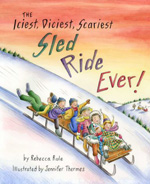 Grandpa Bud has charmed his granddaughter, Lizzie, with tales of his adventurous slides down the hill on Old Mountain Road, so when an winter day comes along that freezes the snow on the hill into ice, Lizzie has a plan. She and several of her friends drag out Grandpa’s old travois sled, complete with runners and room for all on the bench, and start their trek up the hill. This is no easy task slipping and sliding just trying to get UP the hill. Once atop this “hill”, it looks mountainous! Thermes has done an outstanding job of painting the fear onto the kids’ faces that will bring a chuckle to readers. Now for the moment to begin … the push off … and down they go! Several pages of speed and slipping and sliding but pure frivolity and fun (though parents may not agree!) This delightful story has a touch of nostalgia and a huge dose of humor great for a winter day. Introduce this book with the book trailer or learn more about the author and illustrator at Islandport Press website.
Grandpa Bud has charmed his granddaughter, Lizzie, with tales of his adventurous slides down the hill on Old Mountain Road, so when an winter day comes along that freezes the snow on the hill into ice, Lizzie has a plan. She and several of her friends drag out Grandpa’s old travois sled, complete with runners and room for all on the bench, and start their trek up the hill. This is no easy task slipping and sliding just trying to get UP the hill. Once atop this “hill”, it looks mountainous! Thermes has done an outstanding job of painting the fear onto the kids’ faces that will bring a chuckle to readers. Now for the moment to begin … the push off … and down they go! Several pages of speed and slipping and sliding but pure frivolity and fun (though parents may not agree!) This delightful story has a touch of nostalgia and a huge dose of humor great for a winter day. Introduce this book with the book trailer or learn more about the author and illustrator at Islandport Press website.
- Karen Hildebrand, Ohio Library and Reading Consultant
Grades 3-6
Frederick, Shane. (2013). The technology of hockey. Mankato, MN: Capstone Press.
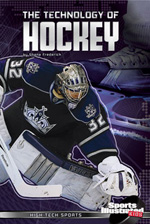 The introduction of this book explains how hockey has been an evolving game from 150 years ago when “the origins of the game of hockey go back that far with skaters playing a game on frozen ponds and rivers with wooden sticks. By the late 1800’s, the first rules were written down and clubs began to form.”(p. 4) Now, all the equipment and uniforms and created ice and caretaking of the ice, and the organization of the NHL and The Stanley Cup have transformed the sport of hockey. Much of this transformation has come in the design of the new equipment and care of the ice. Even the puck, once just a chunk of wood or coal or whatever substance was handy, is now made of vulcanized rubber mixed with sulfur and frozen to keep them from bouncing too much. Hockey sticks are made of graphite, Kevlar, fiberglass and titanium. This is just the beginning. Information on skates, protective headgear, leg pads, ice temperatures, ice rinks and stadiums, the Zamboni machine, the boards and glass around the rinks, are included. This book is packed full of facts and information about the sport of hockey. Intermediate readers might enjoy the information found at the NHL website for kids.
The introduction of this book explains how hockey has been an evolving game from 150 years ago when “the origins of the game of hockey go back that far with skaters playing a game on frozen ponds and rivers with wooden sticks. By the late 1800’s, the first rules were written down and clubs began to form.”(p. 4) Now, all the equipment and uniforms and created ice and caretaking of the ice, and the organization of the NHL and The Stanley Cup have transformed the sport of hockey. Much of this transformation has come in the design of the new equipment and care of the ice. Even the puck, once just a chunk of wood or coal or whatever substance was handy, is now made of vulcanized rubber mixed with sulfur and frozen to keep them from bouncing too much. Hockey sticks are made of graphite, Kevlar, fiberglass and titanium. This is just the beginning. Information on skates, protective headgear, leg pads, ice temperatures, ice rinks and stadiums, the Zamboni machine, the boards and glass around the rinks, are included. This book is packed full of facts and information about the sport of hockey. Intermediate readers might enjoy the information found at the NHL website for kids.
- Karen Hildebrand, Ohio Library and Reading Consultant
Hurley, Michael. (2013). Ice hockey (Read Me! Fantastic Sports Facts). Chicago: Heinemann/Raintree.
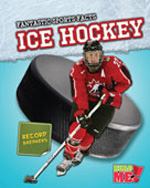 From the Read Me! Fantastic Sports Facts series, this volume is full of factoids rather than a narrative about the sport. Using single paragraphs, framed boxes, diagrams or circles of facts, this book will appeal to the reluctant reader. Plentiful colorful facts and frames fill this book with all sorts of information about players, statistics, equipment, famous moments in the game and more. Readers will enjoy the Quiz and Fanometer at the end along with the glossary and other resources for further reading. Enjoy this YouTube video entitled "Hockey Kids."
From the Read Me! Fantastic Sports Facts series, this volume is full of factoids rather than a narrative about the sport. Using single paragraphs, framed boxes, diagrams or circles of facts, this book will appeal to the reluctant reader. Plentiful colorful facts and frames fill this book with all sorts of information about players, statistics, equipment, famous moments in the game and more. Readers will enjoy the Quiz and Fanometer at the end along with the glossary and other resources for further reading. Enjoy this YouTube video entitled "Hockey Kids."
- Karen Hildebrand, Ohio Library and Reading Consultant
Obed, Ellen Bryan. (2012). Twelve kinds of ice. Illustrated by Barbara McClintock. Houghton Mifflin.
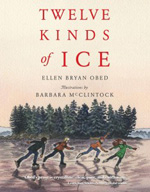 Written in poetic prose and illustrated with McClintock’s beautiful pen-and-ink drawings this small book reflects the memories of waiting for the ice. In the first of twenty short chapters, the Bryan family and their neighbors enjoy the coming of winter as they watch the stages of ice begin to form. The ice starts as a thin sheet on a bucket of water, the next ice is like glass, but when the third stage of ice comes it doesn’t break – a sign it is just about right for skating. Field ice, stream ice and the scary black ice are next to follow. The Bryans are ready to create their garden skating rink by packing down the snow and running the garden hose over the top to create the smooth ice needed for skating and hockey. The winter fun really begins now and a skating party is a must. The end of the story has the ice melting and all the lost mittens and hockey pucks reappear from the winter. Words and pictures work so well together in this heartfelt book. Read more about the author at her website and the illustrator’s work at her award-winning website.
Written in poetic prose and illustrated with McClintock’s beautiful pen-and-ink drawings this small book reflects the memories of waiting for the ice. In the first of twenty short chapters, the Bryan family and their neighbors enjoy the coming of winter as they watch the stages of ice begin to form. The ice starts as a thin sheet on a bucket of water, the next ice is like glass, but when the third stage of ice comes it doesn’t break – a sign it is just about right for skating. Field ice, stream ice and the scary black ice are next to follow. The Bryans are ready to create their garden skating rink by packing down the snow and running the garden hose over the top to create the smooth ice needed for skating and hockey. The winter fun really begins now and a skating party is a must. The end of the story has the ice melting and all the lost mittens and hockey pucks reappear from the winter. Words and pictures work so well together in this heartfelt book. Read more about the author at her website and the illustrator’s work at her award-winning website.
- Karen Hildebrand, Ohio Library and Reading Consultant
Omoth, Tyler. (2013). Ice fishing for kids. Mankato, MN: Capstone Press.
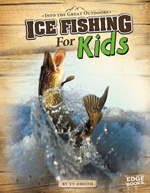 Opening with a photograph of a fisherman sitting on the ice with fishing pole in hand as it pokes through the ice awaiting a fish, the book starts with “Frozen Fun.” (p. 4) Beginning with the history of ice fishing, the author continues with the gear that is needed and how to find or create shelter during this frozen fun. He explains about ice fishing rods, ice augers to cut the hole in the ice, fish finding gadgets, tip-ups that “allow you to set your bait in the water and walk away.” (p.13), and fishing contests. Chapter 3 deals with Tips and Techniques for the amateur ice fisherman while Chapter 4 goes on to discuss safety issues. The book concludes with aspects of conservation and working with the environment. Small fact boxes are inserted throughout the box in addition to framed paragraphs for different historical or interesting stories about this sport. A glossary, index and further resources can be found at the end.
Opening with a photograph of a fisherman sitting on the ice with fishing pole in hand as it pokes through the ice awaiting a fish, the book starts with “Frozen Fun.” (p. 4) Beginning with the history of ice fishing, the author continues with the gear that is needed and how to find or create shelter during this frozen fun. He explains about ice fishing rods, ice augers to cut the hole in the ice, fish finding gadgets, tip-ups that “allow you to set your bait in the water and walk away.” (p.13), and fishing contests. Chapter 3 deals with Tips and Techniques for the amateur ice fisherman while Chapter 4 goes on to discuss safety issues. The book concludes with aspects of conservation and working with the environment. Small fact boxes are inserted throughout the box in addition to framed paragraphs for different historical or interesting stories about this sport. A glossary, index and further resources can be found at the end.
- Karen Hildebrand, Ohio Library and Reading Consultant
Polydorios, Lori. (2013.) Snowboarding greats. Mankato, MN: Capstone Press.
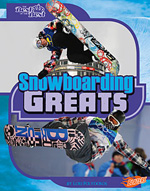 Snowboarding is a popular winter sport and has made headlines through recent Olympic games. This little volume gives a double page spread to 12 famous snowboarders. Starting with Lindsey Jacobellis, who competed in Winter Games X, other noted snowboarders include Stevie Bell, Danny Kass, Andreas Wiig, Kevin Pearce, Gigi Rüf, Shaun Palmer, Nicolas Muller, Terje Haakonsen, Shaun White, Travis Rice, and John Jackson. Each double page spread contains fact boxes; some labeled Tricked Out that point out a special trick unique to that snowboarder or other colored fact boxes that define a snowboarding term. A glossary and extra resources are included in the back of the book.
Snowboarding is a popular winter sport and has made headlines through recent Olympic games. This little volume gives a double page spread to 12 famous snowboarders. Starting with Lindsey Jacobellis, who competed in Winter Games X, other noted snowboarders include Stevie Bell, Danny Kass, Andreas Wiig, Kevin Pearce, Gigi Rüf, Shaun Palmer, Nicolas Muller, Terje Haakonsen, Shaun White, Travis Rice, and John Jackson. Each double page spread contains fact boxes; some labeled Tricked Out that point out a special trick unique to that snowboarder or other colored fact boxes that define a snowboarding term. A glossary and extra resources are included in the back of the book.
- Karen Hildebrand, Ohio Library and Reading Consultant
Spinelli, Eileen (2012). Cold snap. Illus. by Majorie Priceman. New York: Random House/Alfred A. Knopf.
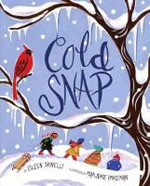 In some ways, this beautiful book could function as a sequel to the book Heat Wave (2007) by the same author. Told from the perspective of the citizens of small town Toby Mills, the narrative describes a wintertime celebration during one very cold week. On Saturday, the temperature falls, growing so cold that an icicle forms on the nose of General Toby’s statue. The cold weather and growing icicle cannot keep people from attending church on Sunday. On Monday the dedicated teachers head off to work; on Tuesday Mille scatters seeds for the birds braving the chilly air, and on Wednesday, bitter cold wind tosses things around. Conditions worsen on Thursday when the temperature plummets to zero. On Friday, General Toby’s icicle stretches to the ground. Despite the cold weather, the town’s mayor holds a feast on top of a snowy hill, with a roaring bonfire, snow candy, hot cider and doughnuts, all in celebration of winter. The next morning, the bright sun has shattered the icicle on General Toby’s nose. Lively illustrations and a recipe for making sugar-on-snow candy add to the book’s charm.
In some ways, this beautiful book could function as a sequel to the book Heat Wave (2007) by the same author. Told from the perspective of the citizens of small town Toby Mills, the narrative describes a wintertime celebration during one very cold week. On Saturday, the temperature falls, growing so cold that an icicle forms on the nose of General Toby’s statue. The cold weather and growing icicle cannot keep people from attending church on Sunday. On Monday the dedicated teachers head off to work; on Tuesday Mille scatters seeds for the birds braving the chilly air, and on Wednesday, bitter cold wind tosses things around. Conditions worsen on Thursday when the temperature plummets to zero. On Friday, General Toby’s icicle stretches to the ground. Despite the cold weather, the town’s mayor holds a feast on top of a snowy hill, with a roaring bonfire, snow candy, hot cider and doughnuts, all in celebration of winter. The next morning, the bright sun has shattered the icicle on General Toby’s nose. Lively illustrations and a recipe for making sugar-on-snow candy add to the book’s charm.
- Rani Iyer, Washington State University Pullman
Grades 5-8
Frederick, Shane. (2013). The ultimate collection of pro hockey records. Mankato, MN: Capstone Press.
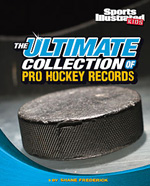 True hockey fans will delight in this book as it contains a plethora of information and tidbits about hockey’s greatest moments and its best players. Part of the Sports Illustrated for Kids series, the design of this book is a collage of information that uses charts, diagrams, photographs, factoid boxes, and short narrative paragraphs to draw readers into the game of hockey. The contents include: Records on the ice; Skater records; Goaltending records; Team records; Stanley cup playoffs; Around the ice. The book ends with a detailed index, related reading and suggested internet sites for further research.
True hockey fans will delight in this book as it contains a plethora of information and tidbits about hockey’s greatest moments and its best players. Part of the Sports Illustrated for Kids series, the design of this book is a collage of information that uses charts, diagrams, photographs, factoid boxes, and short narrative paragraphs to draw readers into the game of hockey. The contents include: Records on the ice; Skater records; Goaltending records; Team records; Stanley cup playoffs; Around the ice. The book ends with a detailed index, related reading and suggested internet sites for further research.
- Karen Hildebrand, Ohio Library and Reading Consultant
Grades 9-12
Northrop, Michael. (2011). Trapped. New York: Scholastic.
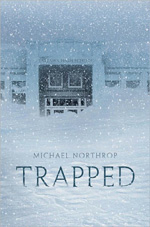 Students (yes, and secretly, teachers) often are delighted when snow causes schools to close, and they have an unplanned day of freedom. At first that’s exactly the reaction of seven students trapped unexpectedly in their high school by an extreme blizzard. But things go wrong quickly. Not only must they figure out how to survive, but the students must also deal with boredom and group dynamics. The author effectively describes the relentless falling of the snow, considered at first an inconvenience since the students' cell phones don't work, and then later, much more than that, as it rises higher and higher. While different factions form during their time inside the school building as they manage to scrounge up food from the cafeteria and find a way to heat the building temporarily, things tip toward disaster since there are no adults to be found. Since the story is told from the point of basketball player Scotty Weems, readers know that he survives, but the fate of the others isn't clear especially since there are hints throughout the narrative that everyone won't make it. As factions form and romantic possibilities bud, Scotty realizes that he has misjudged some of the others, school bad boy Les in particular. Unfortunately, readers never get to know much about Krista and Julie, the two girls trapped in the building, seemingly included more for sexual tension than character development. Readers will race to the book’s conclusion to see which of the characters survive and head off to warm houses amid a winter wonderland. It’s hard not to imagine the impact of the weight of more than eight feet of snow on the roof of a building and on the world outside that building. The author’s description of the effect of the relentless weather, at first an inconvenience and eventually life-threatening, on ordinary teens is a perfect read during this time of year. Just be sure to put a couple of logs on the fire or turn up the heat first.
Students (yes, and secretly, teachers) often are delighted when snow causes schools to close, and they have an unplanned day of freedom. At first that’s exactly the reaction of seven students trapped unexpectedly in their high school by an extreme blizzard. But things go wrong quickly. Not only must they figure out how to survive, but the students must also deal with boredom and group dynamics. The author effectively describes the relentless falling of the snow, considered at first an inconvenience since the students' cell phones don't work, and then later, much more than that, as it rises higher and higher. While different factions form during their time inside the school building as they manage to scrounge up food from the cafeteria and find a way to heat the building temporarily, things tip toward disaster since there are no adults to be found. Since the story is told from the point of basketball player Scotty Weems, readers know that he survives, but the fate of the others isn't clear especially since there are hints throughout the narrative that everyone won't make it. As factions form and romantic possibilities bud, Scotty realizes that he has misjudged some of the others, school bad boy Les in particular. Unfortunately, readers never get to know much about Krista and Julie, the two girls trapped in the building, seemingly included more for sexual tension than character development. Readers will race to the book’s conclusion to see which of the characters survive and head off to warm houses amid a winter wonderland. It’s hard not to imagine the impact of the weight of more than eight feet of snow on the roof of a building and on the world outside that building. The author’s description of the effect of the relentless weather, at first an inconvenience and eventually life-threatening, on ordinary teens is a perfect read during this time of year. Just be sure to put a couple of logs on the fire or turn up the heat first.
- Barbara A. Ward, Washington State University Pullman
These reviews are submitted by members of the International Reading Association's Children's Literature and Reading Special Interest Group (CL/R SIG) and are published weekly on Reading Today Online. The International Reading Association partners with the National Council of Teachers of English and Verizon Thinkfinity to produce ReadWriteThink.org, a website devoted to providing literacy instruction and interactive resources for grades K–12.